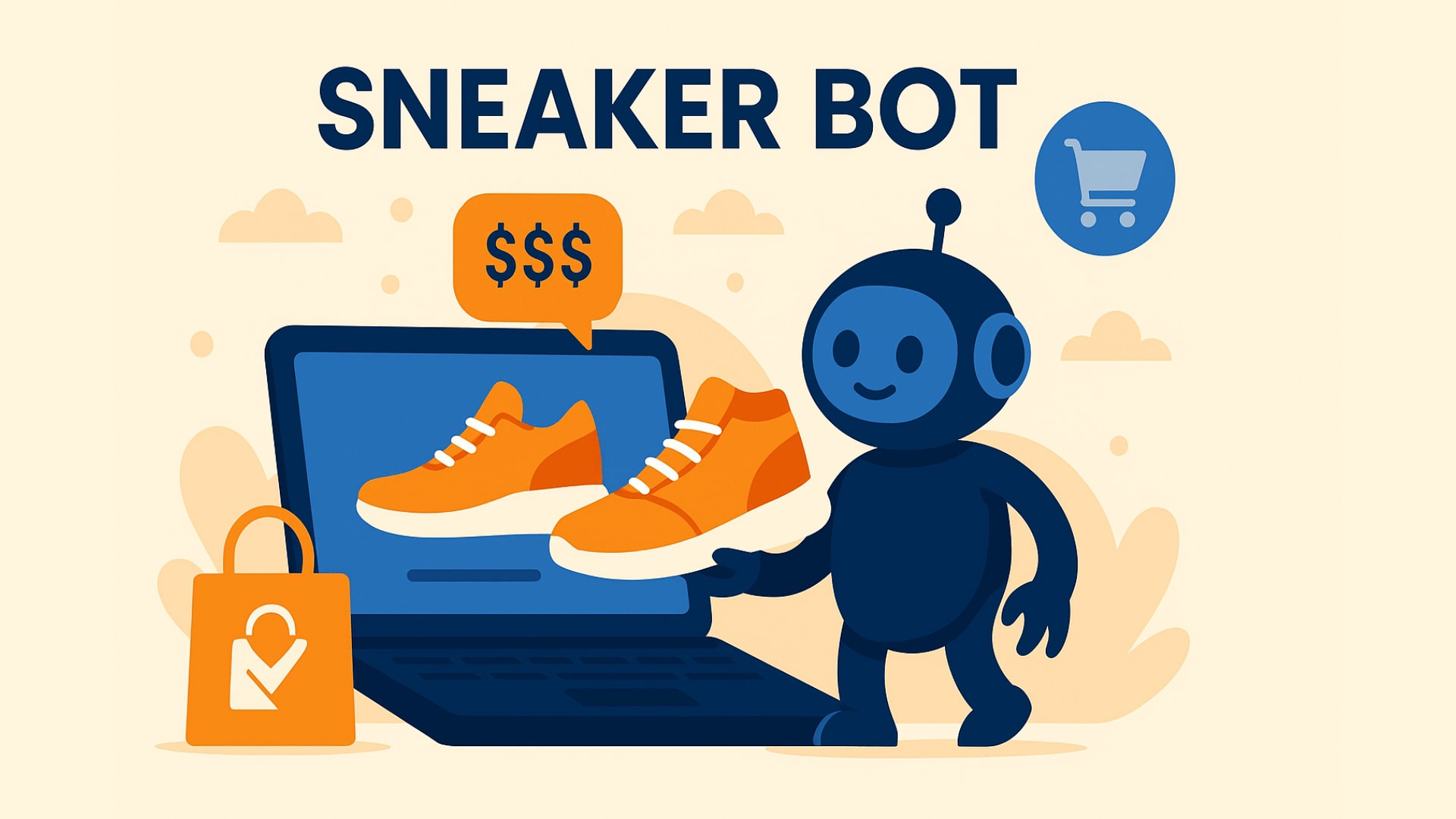
You’ve just launched a limited-edition product. Within seconds, your stock vanishes — not into the hands of eager customers, but into digital shopping carts controlled by unseen scripts. This isn’t a glitch or a surprise surge in demand. It’s the work of sneaker bots.
These specialised programs are designed to outpace human shoppers, securing high-demand products in milliseconds and turning them over to resale markets for inflated prices. For businesses in e-commerce, sneaker bots aren’t just frustrating — they’re a serious cybersecurity and operational threat. They degrade customer trust, skew your analytics and can even bring your infrastructure to its knees.
Understanding how sneaker bots work, the methods behind their speed and the strategies that can counteract them is essential for any brand serious about fair customer access and digital protection.
Table of contents
What Exactly Is a Sneaker Bot?
A sneaker bot is an automated software application specifically designed to purchase limited-edition products — especially sneakers — from online stores at lightning speed. These bots are built to outperform human shoppers, often completing the entire buying process in a matter of seconds. Their primary goal is to secure high-demand stock before real customers even have a chance, usually with the intent to resell items on secondary markets at inflated prices.
To achieve this, sneaker bots monitor product pages in real time, detect availability changes instantly, add items to the cart and complete the checkout process automatically. Their precision and speed make them practically unbeatable in flash sales or product drops. Many bot operators also use multiple user accounts, rotating IP addresses and sophisticated automation to scale their activities and evade detection, gaining a massive and unfair advantage over genuine customers.
How Sneaker Bots Operate
Sneaker bots execute automated tasks based on predefined instructions. They monitor product pages constantly and perform lightning-fast actions when a product becomes available. By auto-filling payment and shipping details, they move through checkout in fractions of a second. Some even mimic human behaviour — simulating mouse movements or keystrokes — to avoid being flagged by basic security tools.
To stay undetected, operators often deploy proxies or VPNs, disguising their IP addresses and making it appear as though traffic originates from a variety of residential locations. This approach helps bypass geographic filters and purchase limits, enabling mass buying from a single bot network.
Damage Done by Sneaker Bots
For consumers, sneaker bots create an unfair shopping environment. Limited-release items become inaccessible through normal means, pushing loyal customers toward overpriced resale platforms. This erodes brand trust and loyalty.
For businesses, the damage is multifaceted. Infrastructure can be overwhelmed as bots flood the site with traffic, leading to crashes or slowdowns that affect all users. Analytics become unreliable, as fake traffic distorts your understanding of customer behaviour. Bots can also hoard inventory, causing apparent demand spikes that lead to inaccurate stock planning and marketing decisions.
Legal and Ethical Landscape
Currently, the use of sneaker bots isn’t explicitly outlawed in many jurisdictions, including the UK. While some countries have attempted to regulate ticket scalping bots, retail bots remain in a legal grey area. However, most e-commerce platforms prohibit their use within their terms and conditions. Brands may ban accounts, cancel suspicious orders, or withhold refunds if abuse is detected — but the burden of defence largely rests with the retailer.
Varieties of Sneaker Bots
Sneaker bots are not all the same. Scraping bots monitor web pages to detect product launches instantly. Footprinting bots probe websites to discover hidden or early-access product URLs. Account creation bots generate hundreds of fake customer accounts, while account takeover bots use stolen credentials to hijack existing ones. Scalping bots complete purchases faster than real customers can react and denial-of-inventory bots add items to carts to make them appear sold out. Each type presents its own challenges and requires a tailored mitigation strategy.
The Challenges of Detection
Bot developers are constantly adapting and their tools grow more sophisticated with each release. Advanced sneaker bots can spoof browser fingerprints and use residential IP proxies to appear authentic. Some even use AI to solve CAPTCHA challenges. Because of this, simple security tools like rate limiting or basic bot detection scripts often fall short. Detecting these bots requires a multi-layered, adaptive approach.
Protecting Your Store from Sneaker Bots
Successful bot mitigation starts with understanding traffic patterns. Behavioural analytics tools can help identify non-human behaviour — such as high-speed click paths, abnormal session durations, or unrealistic navigation speeds. Digital fingerprinting tools create user profiles based on browser and device data, helping to identify and block bots masquerading as legitimate users.
Blocking traffic from known data centre IP ranges and enforcing rate limits are also useful in filtering out low- and mid-tier bots. More advanced defences include virtual waiting rooms, which randomise access to limited-release product pages and throttle entry into checkout queues. Post-purchase audits can identify suspicious orders for cancellation and member-only releases can ensure that only trusted users gain access to exclusive drops.
CAPTCHA systems provide a strong front-line defence by introducing challenges that are difficult for bots to solve. While advanced bots may still find ways around traditional CAPTCHAs, modern, privacy-compliant alternatives, like those from captcha.eu, are increasingly effective — particularly when integrated into a layered security framework.
Conclusion
Sneaker bots represent a growing threat to the fairness, integrity and performance of online retail. They exploit speed, anonymity and automation to gain an unfair advantage, frustrating consumers and challenging retailers at every level.
Protecting your e-commerce platform from these automated attacks requires a blend of real-time traffic analysis, intelligent access control, user validation tools and adaptive CAPTCHA technology. By investing in proactive bot mitigation strategies, businesses can preserve customer trust, improve site performance and ensure that high-demand products reach genuine buyers — not just the fastest scripts. Solutions, like those offered by captcha.eu, can play a vital role in safeguarding your online store against today’s most sophisticated automated threats.
FAQ – Frequently Asked Questions
What is a sneaker bot?
A sneaker bot is an automated software tool designed to quickly purchase limited-edition sneakers or products from online retailers. It bypasses human speed limits during checkout, giving bot users an unfair advantage over real shoppers.
How do sneaker bots affect online stores?
Sneaker bots can overload servers, distort traffic analytics, and deny real customers access to products. This can harm a store’s reputation, increase infrastructure costs, and reduce customer satisfaction and loyalty.
Are sneaker bots illegal?
While not explicitly illegal in most countries, sneaker bots often violate the terms of service of online stores. Retailers may cancel orders or ban accounts suspected of bot usage.
Can CAPTCHAs stop sneaker bots?
CAPTCHAs can block basic bots by challenging them with tasks difficult for machines to solve. Advanced bots may bypass some CAPTCHAs, but modern, privacy-compliant CAPTCHA solutions — like those from captcha.eu — are designed to detect and slow even sophisticated automated threats.
How can businesses protect against sneaker bots?
A layered strategy is most effective. This includes traffic monitoring, rate limiting, digital fingerprinting, virtual waiting rooms, CAPTCHAs and post-sale audits. Restricting access through verified membership or loyalty programs also helps limit bot activity.
100 free requests
You have the opportunity to test and try our product with 100 free requests.
If you have any questions
Contact us
Our support team is available to assist you.




